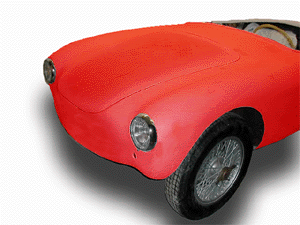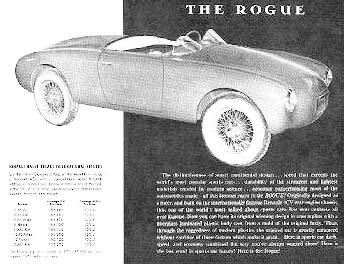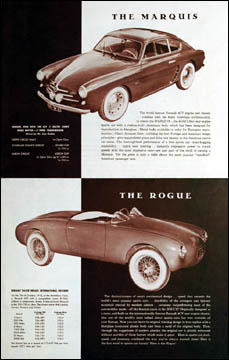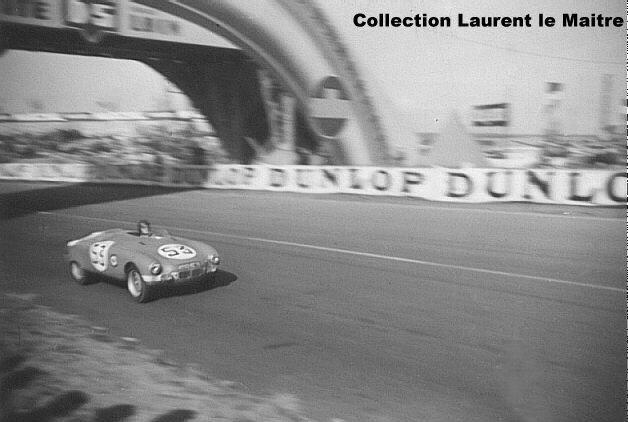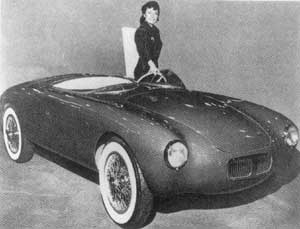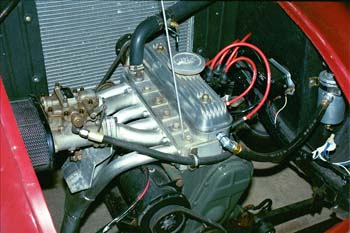La Rogue: an US 4cv….
LINK TO MAIN PAGE
The Rogue's history starts with Louis Rosier, the French racing ace and owner of a Renault dealership in Clemont-Ferrand. Along with Talbot-Lago and Ferrari, he raced a Renault 4CV. With a desire to produce a series of special 4CV based cars, in 1952 he commissioned Motto of Turin to construct a two-seater aluminum on a 4CV punt. The coupe was too expensive to produce.In 1953 the Rosier 4CV Barquette was constructed and ran at Le Mans. It finished twenty third overall.
After an oficial presentation to the press, Louis Rosier, shows an other car built with Renault racing departement. This car is given for 180 km/h
At least two Rosier 4CV barquette where produced. A car with registration 154-AV-63 was shown in Renault factory court yard in 1953. This car appears appears to be a street car, with the notable features of Borrani wire wheels and the lack of a front grill.
In June of 1953 a second car,the race version, with the registration 8260-BZ75 was shown at the factory along with the other two Renault specials by Vernet-Pairard. The notable features are the lack of the Borranis, presents of the distinctive front grill and rear wheel spats.
In March of 1954 the "Rogue" is shown at the New York International Motor Sports Show.
Also present at the show is the "Marquis" Jean Redele's second prototype 4CV based coupe constructed by Allemano. A deal was made with Plasticar, to produce matrix molds for Redele in exchange for license rights in the USA.
Arrangements where made for Plasticar Inc. to purchase 150 chassis punt sets from Renault of France.
After several weeks with no word from Plasticar, Jean Redele arrives at Plasticar facility, to find that his car the Marquis left to have matrix molds made, has been parted out an the drivetrain installed in the Rogue. The deal falls apart. Redele ends up purchasing the 150 punts from Renault. Redele has Chappe and Gosselin produce bodied from his third high roof prototype.
The A106 and the Alpine marque are created.
Details of Plasticar demise are not know yet.Other than the Rogue was too exspensive and small for American tastes. Plasticar also had overheating problems with the car due the lack of experience with the rear engined cars. It has been said that the workers from Plasticar went on an worked at Almquist Engineering, which produced fiberglass bodies for many sportscar as well as for a Renault 4CV.
The Rogue now equipped with the motor, five speed transaxle, and rear four shock absorber suspension from Jean Redele Alpine prototype, becomes a road racing special. Unfortunately the weight of the overly thick fiberglass body makes the car uncompetive against the top car in the northeast, Candy Poole's PBX special.
In 1959 Ronald Fitzgerald and Larry Yoder , two young racers purchase the Rogue from a elderly gentlemen, most likely Zark Reed of Plasticar. The continue to hillclimb the car with mixed sucess. The car is sold of several years later to another racer.
In the early 1970's, now missing its motor, interior, and all trim, the car is to be scrapped. Fortunately the tow truck driver, Dave Damiani, a long time Renault owner and fan, recognizes the car from his youth when he drove the car and tried to buy it from Yoder and Fitzgerald. The car is stored in his barn till I purchased the car in 1997.I still do not know the original details of the nature of the arrangement between Louis Rosier and Zark Reed.
Todd Daniel
Pennslyvania USA
Cick on thumbnail pictures to enlarge and select :

















NOUVELLEES IMAGES DE LA RESTAURATION DE LA ROGUE : (Février 2004)
La historia de la “Rogue” comienza con el famoso Louis Rosier, famoso piloto francés propiretario de un concesionario Renault en Clermont-Ferrand. Habituado a los Talbot-Lago y los Ferrari, corre con los 4cv en los años 50.
Rosier deseaba construir una pequeña serie sobre la mecánica del 4cv, y en 1952, le pide a Motto de Turín que realice el estudio de una barqueta biplaza con la carrocería de aluminio y el chasis 4cv. Su construcción resultó muy costosa..., pero ese mismo año se presentó la barqueta gracias a la colaboración del servicio de competición de la Régie. Se anunciaba una velocidad de 180 km/h.
Por lo menos dos barquetas se construyeron. En la foto una con la matrícula 154 A V 63 en el patio de la fábrica de Renault en 1953. Parece tratarse de una versión “de calle”, -a notarse las llantas de hilos Borrani y una calandra desnuda...En 1953 una barqueta 4cv se construyó y participó en las 24 Horas de La Mans acabando 23º.
En junio de 1953, un segundo vehículo “versión carreras”, inmatriculada 8260 BZ 75 estuvo expuesta en fábrica al lado de otros dos Vernet-Pairard. Ëste ya no tenía las llantas de hilos Borrani pero si una parrilla de calandra además de elementos aerodinámicos encima de las ruedas traseras.
En Marzo de 1954, se presentó en el International Motor Show de New York.En este caso se trata de una barqueta 4cv fabricada en asociación con Plasticar Inc de Doylestown, Pennsylvanie en USA. Se caracteriza por estar fabricada con fibra de vidrio, material High-Tech para la época. Carece de puertas y tiene un alza reforzada alrededor del habitáculo, llantas de hilos Borrani y una parrilla de calandra específica para esta versión. El color, un rojo brillante especial puesto directamente en la resina de poliéster.
En NY también se presentó otro prototipo basado en el 4cv, el “Marquis”de Jean Rédélé construido por Allemano. Se hicieron acuerdos con Plasticar para construir moldes para la producirlos Jean Redelé a cambio de la licencia de producción en USA.
Los acuerdos consistían en la compra de Plasticar Inc de 150 chasis para Renault Francia.
Tras varias semanas sin noticias por parte de Plasticar, Jean Rédélé visita la factoría de Plasticar y se encuentra sus chasis para el Marquis instalados en el Rogue... Se paralizaron los acuerdos y Rédélé se puso en contacto con Chappe et Gosselin para producir su tercer prototipo con el techo sobre elevado.
Fue el nacimiento de Alpine y la A106.
No se conocen los detalles de la cesión, si que el Rogue era muy caro y pequeño para el gusto americano. Plasticar también tenía problemas de sobrecalentamiento por su poca experiencia con coches con motor trasero y se sabe que los trabajadores de Plasticar fueron a Almquist Engineering que fabricaba carrocerías de fibra para muchos coches de Sport.
El Rogue estaba equipado con un motor con una caja de cambio de cinco velocidades y de una suspensión trasera con cuatro amortiguadores del proto Alpine de Jean Redelé (ancestro de la suspensión mille-miles), convirtiéndose en un modelo de competición especial. Desafortunadamente, el peso y el espesor de fibra de vidrio lo volvían poco competitivo respecto a sus rivales.
En 1959, Ronald Fitzgerald y Larry Yoder, dos jovenes pilotos, recompraron el Rogue muy parecido a Zark Reed de Plasticar. El coche se utilizó para algunas carreras de cuesta con pocos resultados y se volvió a vender a otro corredor años después.
A principio de los 70, con el motor desmontado y sin interior, el coche estaba destinado a destruirse. Afortunadamente, el conductor de un camión de retirada de coches, Dave Damián, propietario en el pasado de un Renault y fan de la marca, reconoció el coche y lo intentó comprar a Yoder y Fitzgerald. Fue puesto en venta en un garaje hasta que Todd Daniel (Pennslyvania USA) lo compró en 1997.
Por Todd Daniel
Traducción y adaptación: avalanche
